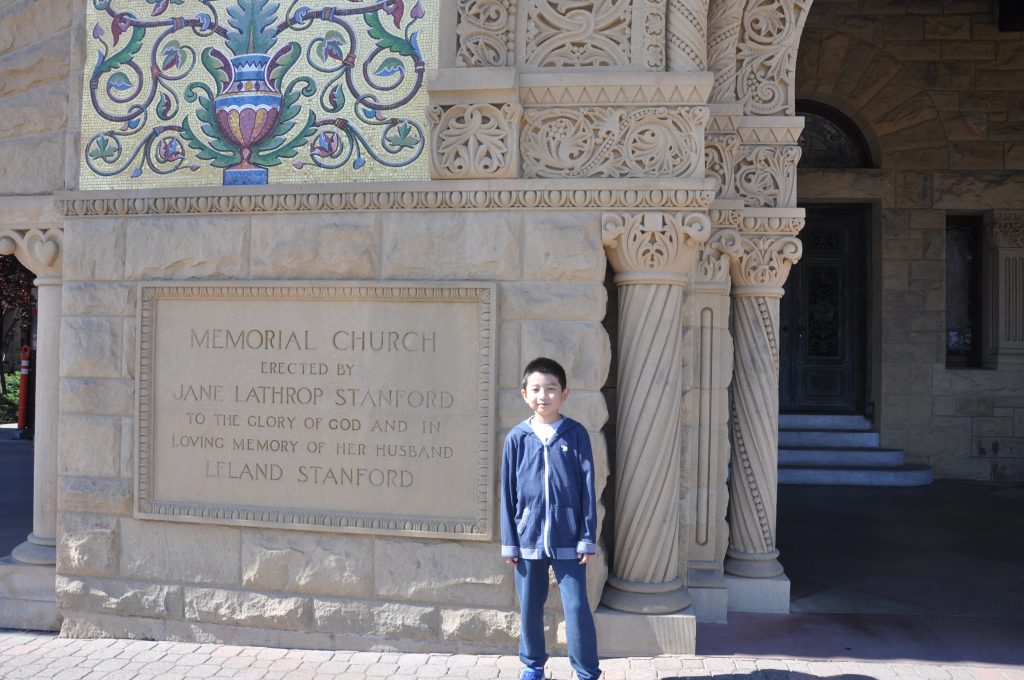Right in the heart of Stanford’s palm-lined campus, tucked among sandstone arches and scholarly chatter, stands a building that quietly tells one of the most moving stories in the university’s history. No, it’s not a lab or lecture hall. It’s the Stanford Memorial Church—a place that proves architecture can carry emotion, history, and a whole lot of soul.

My first visit to Stanford in July 2015 led me straight to the heart of campus—the Memorial Church, where I began a journey filled with warmth and meaning.
Stanford Memorial Church wasn’t built just to impress tour groups or look good on postcards (though, let’s be honest, it does both). It was commissioned by Jane Stanford in memory of her husband, Leland Stanford—yes, that Stanford. But more than a love letter carved in stone and glass, it’s a living symbol of the values the university was founded on: love, remembrance, faith, and education.
The moment you walk up to it, the church takes your breath away—not in a flashy, over-the-top Vegas way, but in the quiet, goosebump-raising kind of way. Its design blends early Gothic and Romanesque revival styles, like something out of an old European village, but with a California twist. The high spires and dramatic arches look like they’re reaching for the sky—maybe because that’s kind of the point. This is a space built for reflection, both spiritual and intellectual.
And the details? Let’s talk about those. The outside walls are dressed with stunning mosaics, and just beneath the main mural are four shimmering angels—each representing Love, Hope, Faith, and Charity. They sound like the names of an old-school Motown girl group, but they’re actually timeless ideals that have held this community together for generations.
Step inside, and it’s like entering a stained-glass storybook. The sunlight filters through vibrant biblical scenes, casting colors on the pews and the people sitting in them—students, faculty, newlyweds, musicians, even the occasional curious squirrel (this is Stanford, after all). Every window tells a story, and together, they whisper a bigger message: education isn’t just about information; it’s about transformation.
But this church isn’t just a pretty place to sit. It’s seen some major moments. It hosted Leland Stanford’s memorial service back in 1893. It was a gathering place for mourners after the 1906 San Francisco earthquake. And in 2011, it held a private farewell for Steve Jobs, a man who literally reshaped the way we connect with the world. Not bad for one building, huh?
And of course, there’s the weddings. Thousands of them. For generations, Stanford grads have returned to say “I do” beneath the church’s golden mosaics. There’s something poetic about beginning a lifelong partnership in a space built out of love and legacy. Plus, it doesn’t hurt that the photos turn out amazing.
But here’s the thing I love most about Stanford Memorial Church: it’s not just a church. It’s a classroom in disguise. A sanctuary of slow thinking in a world addicted to speed. A reminder that while GPAs and research papers matter, so do kindness, community, and character. It teaches us that education isn’t just about what you know, but who you become.
In a university known for cutting-edge tech and billion-dollar startups, this old stone building reminds us of something essential: we stand on the shoulders of those who came before. Jane Stanford didn’t just build a church—she left behind a message. One that says: love deeply, live meaningfully, and leave things better than you found them.
So next time you’re on campus, stop by. Sit for a moment. Let the light hit your notebook. Listen to the silence. You don’t have to be religious to feel something sacred there. You just have to be human.
Because at its heart, Stanford Memorial Church is about all of us—about what we remember, what we believe in, and what we hope to pass on. And in a world that often feels like it’s moving too fast, that’s one legacy worth slowing down for.
